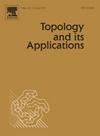Topological representations of bornological spaces and coercive maps
IF 0.5
4区 数学
Q3 MATHEMATICS
引用次数: 0
Abstract
We exhibit the duality between bornological spaces and a certain class of topological spaces of independent interest: the topological spaces of the cofinite type. The usual way to make the bornological spaces a category Bor is to take for morphisms bornological maps [9]. If we instead take coercive maps as discussed in [5] as morphisms, we obtain a very different category Bor⁎ that is isomorphic to the category of topological spaces of the cofinite type equipped with continuous maps as morphisms. We introduce a bornology on the bornological maps bor between bornological spaces and . Membership of to this bornology means that the bornological maps in E are subject to a uniform growth bound. This growth bound can be expressed in terms of an expansion modulus, i.e., an increasing function between and mapping nonempty members of to nonempty members of . We introduce a parallel bornology on the coercive maps cocv between the bornological spaces as well. Notably, evaluation as defined on bor is a bornological map, whereas evaluation may fail to be a coercive map on cocv.
bornological空间和强制映射的拓扑表示
我们展示了拓扑空间与一类独立感兴趣的拓扑空间:有限型拓扑空间之间的对偶性。使bornological空间成为一个范畴Bor的通常方法是取态射的bornological映射[9]。如果我们把[5]中讨论的强制映射作为态射,我们得到一个非常不同的范畴Bor,它与具有连续映射作为态射的有限型拓扑空间的范畴同构。我们在(X,B)和(Y,C)之间的bornological map bor(X,Y)上引入了bornological。E的蔓生图(X,Y)隶属于该蔓生图,即E中的蔓生图服从于一个一致的生长界。这个生长界可以用展开模来表示,即B和C之间的一个递增函数,将B的非空元素映射到C的非空元素。我们还在这两个bornological空间之间的强制映射cocv(X,Y)上引入了一个平行bornological。值得注意的是,在bor(X,Y)×X上定义的求值是一个bornological map,而在cocv(X,Y)×X上的求值可能不是一个强制映射。
本文章由计算机程序翻译,如有差异,请以英文原文为准。
求助全文
约1分钟内获得全文
求助全文
来源期刊
CiteScore
1.20
自引率
33.30%
发文量
251
审稿时长
6 months
期刊介绍:
Topology and its Applications is primarily concerned with publishing original research papers of moderate length. However, a limited number of carefully selected survey or expository papers are also included. The mathematical focus of the journal is that suggested by the title: Research in Topology. It is felt that it is inadvisable to attempt a definitive description of topology as understood for this journal. Certainly the subject includes the algebraic, general, geometric, and set-theoretic facets of topology as well as areas of interactions between topology and other mathematical disciplines, e.g. topological algebra, topological dynamics, functional analysis, category theory. Since the roles of various aspects of topology continue to change, the non-specific delineation of topics serves to reflect the current state of research in topology.
At regular intervals, the journal publishes a section entitled Open Problems in Topology, edited by J. van Mill and G.M. Reed. This is a status report on the 1100 problems listed in the book of the same name published by North-Holland in 1990, edited by van Mill and Reed.

 求助内容:
求助内容: 应助结果提醒方式:
应助结果提醒方式:


